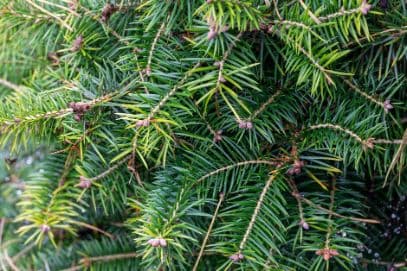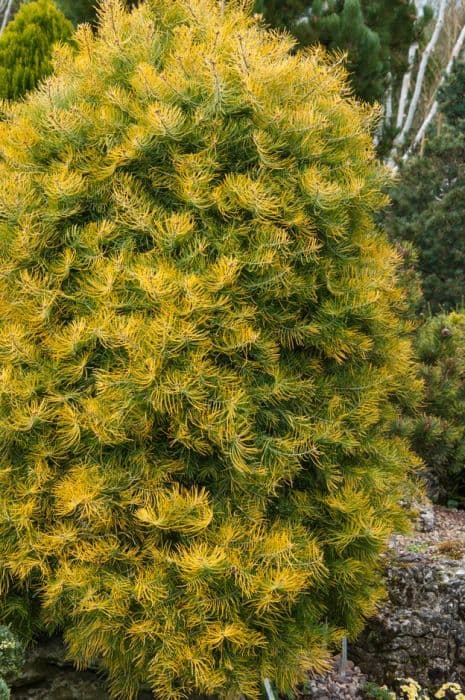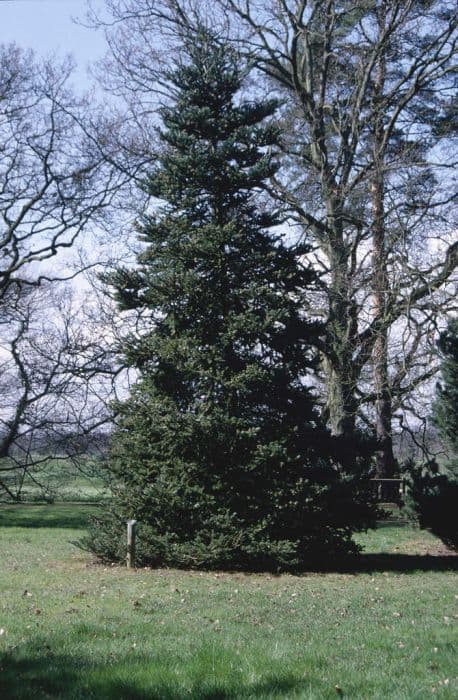Austrian Pine Pinus nigra

ABOUT
Pinus nigra, commonly known as the Austrian pine or black pine, is a coniferous tree characterized by a dense, pyramidal to cylindrical shape in youth, becoming more irregular with age. The bark is deeply fissured and ranges in color from gray to black, providing a rugged texture. Its branches are robust and horizontal, giving the tree a sturdy appearance. The needles of the Austrian pine are long, stiff, and dark green, typically presented in bundles of two. They are glossy and can persist on the tree for several years, contributing to the dense appearance of the foliage. Austrian pine is notable for its robust, oval-shaped cones that are thick-scaled and woody. The cones are usually brown, mature in about two years, and are often held on the tree for several years before dropping. Overall, the Austrian pine presents a bold and enduring appearance, with its rich green needles, stout branches, and rough bark providing a distinctive and evergreen presence in the landscape.
About this plant
 Names
NamesFamily
Pinaceae.
Synonyms
Austrian Pine, Black Pine, European Black Pine, Corsican Pine.
Common names
Pinus nigra ssp. pallasiana, Pinus mairei, Pinus pallasiana, Pinus laricio var. corsicana, Pinus laricio var. calabrica, Pinus laricio var. maritima, Pinus laricio var. austriaca, Pinus austriaca, Pinus laricio var. nigra, Pinus nigra var. austriaca, Pinus nigra var. corsicana, Pinus nigra var. maritima, Pinus nigra var. pallasiana, Pinus nigricans, Pinus salzmannii var. corsicana.
 Toxicity
ToxicityTo humans
The plant Pinus nigra, commonly known as the Austrian pine, is not generally known to be toxic to humans. While ingesting parts of this plant is not recommended and could potentially cause gastrointestinal discomfort due to the irritating nature of plant fibers and oils, there is no significant toxicity associated with this pine species to humans. The pine needles, if ingested in large quantities, might cause a mild stomach upset but typically do not lead to serious health consequences.
To pets
For pets, particularly cats and dogs, the Austrian pine, or Pinus nigra, is also considered to be of low toxicity. Eating small amounts of pine needles may result in mild gastrointestinal irritation, such as vomiting or diarrhea, due to the mechanical irritation of the needles and the oils they contain. However, there are no severe toxic compounds in this plant that are known to pose a serious threat to pet health. Still, it's wise to prevent pets from ingesting plant material to avoid potential digestive upset.
 Characteristics
CharacteristicsLife cycle
Perennials
Foliage type
Evergreen
Color of leaves
Green
Height
50 feet [15 meters]
Spread
20 feet [6 meters]
Plant type
Tree
Hardiness zones
4
Native area
Mediterranean
Benefits
 General Benefits
General Benefits- Erosion Control: Pinus nigra, commonly known as the Austrian Pine, has a deep root system that helps stabilize the soil and prevent erosion.
- Windbreak: Its dense foliage can serve as a windbreak, protecting nearby areas from strong winds and storms.
- Habitat and Shelter: The tree provides habitat and protection for wildlife, including birds and small mammals.
- Landscape and Aesthetic Value: The Austrian Pine is often used in landscaping for its aesthetic appeal with its tall, majestic form and dark green needles.
- Shade and Cooling: It can provide dense shade during hot summers, helping to cool down surrounding areas.
- Noise Barrier: When planted in rows or groups, Pinus nigra can act as a sound barrier, reducing noise pollution from roads or industrial areas.
- Privacy Screen: Due to its thick foliage, it can serve as an effective privacy screen for homes and properties.
- Wood Production: The Austrian Pine is a source of timber, used for construction, furniture, and paper production.
 Medical Properties
Medical Properties- Respiratory system aid - Pinus nigra has been traditionally used to help with respiratory problems, including coughs and bronchitis, potentially due to its expectorant properties.
- Antiseptic - The oleoresin from this plant is known to have antiseptic properties, which could help in treating and preventing infections.
- Anti-inflammatory - It may have anti-inflammatory effects which can help in the treatment of inflammation-related conditions.
- Antioxidant - Pinus nigra contains antioxidants which can help in protecting the body against free radical damage.
 Air-purifying Qualities
Air-purifying QualitiesThis plant is not specifically known for air purifying qualities.
 Other Uses
Other Uses- Traditional woodworking: Pinus nigra, commonly known as black pine, has a dense and resinous wood that is valued for traditional woodworking, including furniture making and intricate carving.
- Natural dye: The bark of the black pine can be used to create natural dyes for textiles, offering a range of earthy tones.
- Photography: Pine resin obtained from Pinus nigra was historically used in the production of certain types of early photographic film and printing processes.
- Soil stabilization: Due to its robust root system, black pine is often planted to prevent soil erosion on slopes and in sandy areas.
- Windbreaks: The dense growth habit of Pinus nigra makes it an effective species for use as windbreaks to protect crops and soil from wind damage.
- Wildlife habitat: Black pine forests provide a natural habitat for a variety of wildlife, including birds and small mammals, which rely on the tree for food and shelter.
- Bonsai cultivation: Pinus nigra is a popular species for creating bonsai trees due to its aesthetic branching patterns and foliage.
- Perfumery: The aromatic resin of black pine is sometimes used in the production of perfumes and scents as it has a distinct, earthy fragrance.
- Sound insulation: Black pine wood has properties that make it useful for sound insulation in construction, particularly for reducing noise transmission in walls and floors.
- Christmas trees: In some regions, Pinus nigra is cultivated as a Christmas tree due to its symmetrical shape and full branches.
Interesting Facts
 Feng Shui
Feng ShuiThe Austrian Pine is not used in Feng Shui practice.
 Zodiac Sign Compitability
Zodiac Sign CompitabilityThe Austrian Pine is not used in astrology practice.
 Plant Symbolism
Plant Symbolism- Endurance: The Pinus nigra, or Austrian Pine, is known for its robustness and capacity to withstand challenging conditions, symbolizing the ability to endure hardships.
- Resilience: This tree's adaptability and resilience to diseases and pests signifies bouncing back from adversity and resilience in life.
- Steadfastness: Its firm root system that anchors it firmly to the ground represents steadiness and reliability in the face of life’s challenges.
- Longevity: As a species that can live for hundreds of years, the Austrian Pine symbolizes long life and immortality.
- Protection: With its dense canopy, the tree offers shelter and protection, signifying safety and refuge.
 Water
WaterThe Austrian Pine, commonly known as Pinus nigra, should be watered deeply about once a week during its first growing season to help establish a strong root system. Once established, it's drought-tolerant and usually requires less frequent watering; depending on the climate, every two to three weeks may suffice. During the hot summer months, water the tree once a week, supplying about 10 to 15 gallons per watering for a young tree. Mature trees will require more water but can also rely more on natural rainfall, so adjust as needed. Ensure water penetrates the soil to a depth of at least 12 inches.
 Light
LightThe Austrian Pine thrives best in full sun conditions, requiring at least six hours of direct sunlight each day. Place it in a location where it won't be shaded by buildings or larger trees, as this tree performs optimally with unfiltered, direct sunlight throughout the day.
 Temperature
TemperatureThe Austrian Pine can withstand a range of temperatures but grows best in zones where the average minimum winter temperature does not drop below -20 to -30 degrees Fahrenheit. This tree can handle extremes up to 100 degrees Fahrenheit but prefers cooler conditions. Ideally, the Austrian Pine should be in an environment where temperatures range between 60 and 70 degrees Fahrenheit during the growing season.
 Pruning
PruningPrune the Austrian Pine to remove dead or damaged branches, improve its shape, and promote healthy growth. Pruning is best done in late winter or early spring before the new growth starts. Generally, the tree needs little pruning, and too much can be detrimental. It's important to remove only deadwood and maintain the tree's natural silhouette.
 Cleaning
CleaningNot needed
 Soil
SoilAustrian pine thrives in well-draining soil with a slight acidic to neutral pH ranging from 5.5 to 7.0. The best soil mix consists of one part peat, one part pine bark, and one part coarse sand or perlite to ensure good drainage and aeration.
 Repotting
RepottingAustrian pine should be repotted every 2 to 4 years during its youth to accommodate root growth. Once mature, repotting is rarely necessary as they are generally planted outdoors.
 Humidity & Misting
Humidity & MistingAustrian pine prefers moderate to low humidity conditions and is quite adaptable to drier air, making it suitable for most outdoor environments without specific humidity requirements.
 Suitable locations
Suitable locationsIndoor
Provide bright light, limited water, no indoor humidity control needed.
Outdoor
Plant in sunny spot, well-draining soil, water occasionally.
Hardiness zone
4-7 USDA
 Life cycle
Life cyclePinus nigra, commonly known as the Austrian Pine or Black Pine, begins its life as a seed, which germinates in favorable conditions of moisture and temperature, leading to the emergence of a seedling. The seedling grows into a young sapling, characterized by its establishment of a taproot and beginning of vertical growth. As the sapling matures, it enters a long vegetative stage where it experiences significant height and girth increment, developing a sturdy trunk and a characteristic conical shape. The tree reaches reproductive maturity within 15 to 40 years, at which point it starts producing male cones that release pollen and female cones that, after pollination, develop seeds. These cones mature and the seeds are dispersed through wind or by animals, thus enabling the potential propagation of new Austrian Pines. The tree may live for several hundred years, continuing to grow and reproduce, providing ecological benefits such as habitat for wildlife, before eventually dying due to old age, disease, or environmental factors.
 Propogation
PropogationPropogation time
Spring-Early Summer
The most popular method of propagation for the Austrian pine, which is the common name for Pinus nigra, is by seed. Seed collection typically occurs when the cones are fully mature, which is generally in the fall. To propagate by seed, it is best to mimic the tree's natural conditions, which include a period of cold stratification to break the seed's dormancy. This is done by mixing the seeds with moist sand and storing them in a refrigerator at approximately 34 to 40 degrees Fahrenheit (1 to 4 degrees Celsius) for about 60 days. After cold stratification, the seeds are sown in well-draining soil and exposed to warm temperatures, where germination usually occurs within a few weeks to a few months, depending on conditions. Seedlings require careful attention to watering and should be protected from extreme elements until they are strong enough to be planted in their final location.









